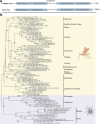Viola phlebovirus is a novel Phlebotomus fever serogroup member identified in Lutzomyia (Lutzomyia) longipalpis from Brazilian Pantanal
- PMID: 29996902
- PMCID: PMC6042282
- DOI: 10.1186/s13071-018-2985-3
Viola phlebovirus is a novel Phlebotomus fever serogroup member identified in Lutzomyia (Lutzomyia) longipalpis from Brazilian Pantanal
Abstract
Background: High throughput sequencing (HTS) boosted the discovery of novel viruses and new variants of known viruses. Here we investigated the presence of viruses in 12 pools of sand flies captured in three climatic periods in RAPELD grids at Rio Claro, Chapada dos Guimarães and at Pirizal, North Pantanal, Mato Grosso State, Midwestern Brazil by HTS, viral isolation of a putative Phlebovirus positive pool in Vero cells, RT-PCR and transmission electron microscopy (TEM).
Results: One pool containing three Lutzomyia (Lutzomyia) longipalpis sand flies captured in the transitional climatic period in North Pantanal showed a tripartite genomic sequence of a putative novel Phlebovirus belonging to the phlebotomus fever serogroup. Phylogenetic analysis revealed this virus is closely related and share a common ancestor with phleboviruses included in the same clade: Chagres, Urucuri and Uriurana virus. RNA-dependent RNA polymerase (RdRP) presented 60%, 59% and 58% of amino-acid (aa) similarity with these phleboviruses, respectively. Similarity of Nucleoprotein and NSs protein codified by ambissense strategy of segment S was of 49% and 37%, respectively, with the proteins of the closest phlebovirus, Uriurana virus. Glycoproteins (G1, G2) and NSm protein presented 49% and 48% aa similarity with Chagres and Uriurana virus, respectively. Uriurana virus was isolated from sand flies in Brazilian Amazon and Urucuri from rodents in Utinga forest, Pará State. Chagres virus is an arbovirus responsible for outbreaks of febrile illness in Panama. This phlebovirus was isolated in Vero cells, confirmed by TEM and RT-PCR for the L segment of the virus, and named Viola phlebovirus.
Conclusions: HTS, viral isolation, RT-PCR and TEM showed the presence of one virus in sand flies from North Pantanal with identity to a putative novel Phlebovirus from phlebotomus fever serogroup, named Viola phlebovirus.
Keywords: Bunyavirales; High throughput sequencing; Phenuiviridae; Phylogeny; RNA virus; Viola phlebovirus; Viral isolation.
Conflict of interest statement
Ethics approval and consent to participate
Not applicable.
Consent for publication
Not applicable.
Competing interests
The authors declare that they have no competing interests.
Publisher’s Note
Springer Nature remains neutral with regard to jurisdictional claims in published maps and institutional affiliations.
Figures





References
-
- Karabatsos N. International catalogue of arthropod-borne viruses. 3rd edition. San Antonio, Texas: American Society of Tropical Medicine and Hygiene for The Subcommittee on Information Exchange of the American Committee on Arthropod-borne Viruses; 1985.
-
- Rodrigues SG, da Rosa T, Vasconcelos PF, Travassos da Rosa ES, Tesh RB. Characterization of two new phleboviruses associated with human illness from the Amazon region of Brazil. An overview of arbovirology in Brazil and neighbouring countries. Belem: Instituto Evandro Chagas; 1998. pp. 100–6.
MeSH terms
Grants and funding
LinkOut - more resources
Full Text Sources
Other Literature Sources
Molecular Biology Databases
Research Materials

